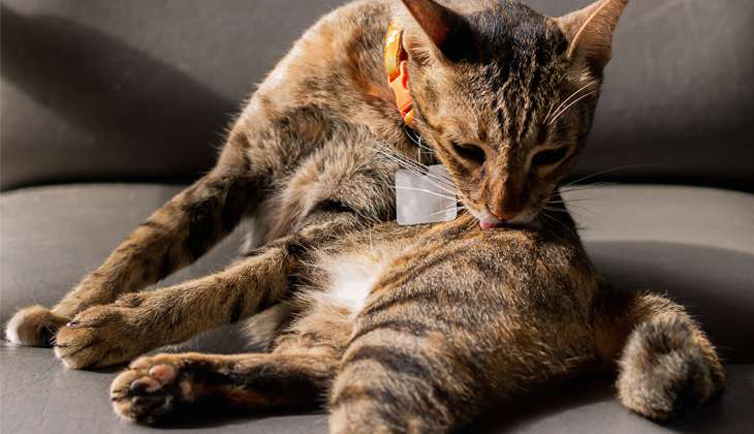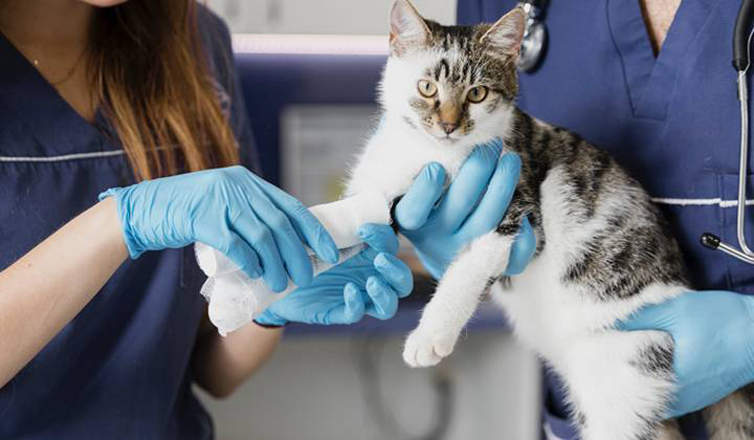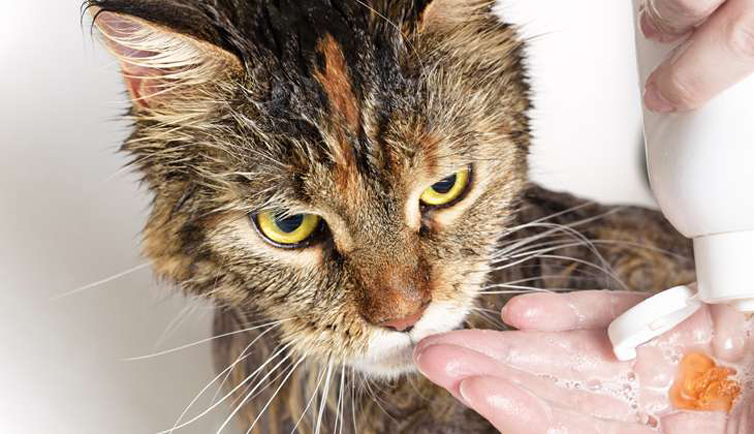Your Itchy, Scratchy Cat – All About Cat Skin Problems
Time for a good night’s sleep for you and your feline friend, but he/she doesn’t stop scratching. Your cat may seem uncomfortable and unable to settle, and you begin to worry that he might have a problem with his skin. On examination, you might notice patches of missing fur, or maybe you see that your cat’s skin looks dry and flaky in certain spots. There are many cat skin problems that commonly affect our feline companions. This will probably entail a visit to your vet, who will diagnose and treat your troubled friend, but it’s also helpful to be a knowledgeable cat owner: to know how to recognize a condition and to understand how cat skin problems will be treated.
CATS

Posted by bravectosouthafrica – 12 April 2021
Cat Mange/Mites
Various species of tiny mites naturally live in the hair follicles at the base of each hair; certain species of these can cause an uncomfortable disease called cat mange. Fortunately, contrary to popular belief, mange in cats is uncommon. This mistaken belief is because far more common skin problems, like flea infestations, have similar symptoms to cat mange. These symptoms can include hair loss, itching, dry scaly skin, red/inflamed skin, restlessness, irritability and excessive grooming and licking.
There are five types of mites, causing cat mange:
- Ear mites (Otodectes cynotis) – Otodectic mange is quite a common cat skin problem. Most people refer to this as ‘ear mites’ rather than cat mange. These tiny mites infest cats’ ears, causing inflammation, itching and irritation. They can also cause head lesions, itchy, dirty ears and head shaking or scratching of ears.
- “Walking dandruff” (Cheyletiella spp.) – Cheyletiellosis mites live on the surface and top layers of the skin. There may be no symptoms or there can be itching, scaliness and crusting on the back. Very few of these mites are required to cause these symptoms and they are more common in rabbits than cats.
- Demodectic Mange (Demodex cati mites) – Demodex cati only causes symptoms in cats who have underlying compromised immune systems or systemic disease, when the numbers of mites increase causing skin lesions. These mites usually live in cats’ skin and are not contagious. Young kittens and older cats are more susceptible.
- Sarcoptic Mange (Sarcoptes scabiei mites) – This cat mite is a less common cause of mange. However, it is highly contagious and can be caught, particularly by cats who come in contact with infected wildlife, infected dogs and other animals. It can even be caught by humans.
- Notoedric Mange (Notoedres cati mites) – This type of mange is rare but is highly contagious to cats and humans.

How is Mange in Cats Treated?
The type of mite infecting your cat will dictate the treatment. Your veterinarian will prescribe the appropriate medication to kill the cat mites. This may need to be applied on the infected skin, put into the infected ear or applied by shampooing, dipping or injection. In the case of serious infections, additional measures, such as antibiotics or antibacterial shampoo, may be used. The vet may ask you to isolate your cat at home to help prevent humans or other pets from being infected. The cat mites are killed by the treatment very quickly, but skin infections, caused by the mites, may take up to a month to heal completely.
As the treatment of cat mites is complex and most types are uncommon, do not try to treat any infestations yourself. It is very important that you take your cat to the vet for him to make a diagnosis first. He/she will take a small skin or swab sample and observe the cat mites under a microscope.
Your veterinarian will then be able to diagnose whether your cat has mites (and the type), or fleas. He/she will then be able to prescribe the right treatment for the infestation. Please note that any home treatments such as insecticides, collars and dips, containing permethrin or amitraz, which are intended and labelled for dogs, are toxic to cats.
How can I prevent mange in my cat?
Wash your cat’s bedding and blankets regularly; vacuum your home often. These are simple ways of effectively helping to prevent cat mange and flea infestation. Most healthy cats, living in homes, are at a low risk of contracting mange.
Fleas
A major cause of excessive itching in cats is the 2,200 types of fleas which occur worldwide.
For more information on fleas, please be sure to check out our articles:
How To Tell If Your Cat Has Fleas? Here Are 9 Signs (Click here)
How Cats Get Fleas Indoors (Click here)
How to Protect Your Cat From Fleas and Ticks (Click here)
Flea Allergy Dermatitis (FAD)
Some cats can develop an allergic reaction to the flea’s saliva when it bites. You may notice bumps and crusts appearing on your cat’s face, back and neck. Repeated licking, scratching and chewing, to alleviate the itching, can worsen the problem and the lesions can become fairly severe. Cats with FAD may have hair loss in addition to these open sores or scabs on their skin, and bacterial infections may result. Your vet will prescribe the best course of treatment.

What is the Treatment for FAD?
There are many effective products on the market to treat and control fleas on your cat and in your home. It is important that the product is long-lasting, such as Bravecto®, which breaks the flea life cycle and gets the flea infestation under control. Many of the other products available must be applied once a month, and people forget. Bravecto® has products which only need to be applied every 3 months for cats, leaving less chance of forgetting and causing a break in treatment.
Click here to read more about Bravecto® for cats.
Ringworm in cats
Ringworm (dermatophytosis), contrary to its name and popular opinion, is not caused by a worm and the classic rash is not always circular. It is a superficial skin infection caused by fungi called dermatophytes. In cats, the infection affects the skin, fur and/or claws. Ringworm can also be contagious and can also infect other animals and people.
How Can I Tell My Cat Has Ringworm?
Some cats may have ringworm without any symptoms or obvious signs, so recognizing it can be difficult. You may notice thickened small or generalized patches of crusted, hairless skin, or you may see an ashy-looking substance in your cat’s coat. Claws may become rough, pitted or even deformed with a scaly base, when infected. Whether a cat shows any signs of ringworm or not, any infected cat can still infect humans and other animals.
How Does Ringworm Spread?
Ringworm is caught by direct contact with the infected animal or person, or by contact with objects or surfaces which have become contaminated.
Most healthy humans and animals usually have resistance to ringworm and contact with an infected person or animal, does not always result in infection. People with compromised immune systems or skin problems are more likely to contract ringworm, as well as the elderly and young children. Contact your doctor immediately if you or any of your family members develop strange or suspicious skin lesions.
How is My Cat’s Ringworm Treated?
Your vet will usually prescribe creams, ointments or special shampoos and/or antifungal medications for your cat. A thorough cleaning and vacuuming of your home and possibly isolating your infected cat, or at least minimizing contact with people and other pets, will help to reduce contamination.
Feline Atopy
Your cat may have or develop an allergy to airborne substances, such as pollen or dust, resulting in atopy, also known as atopic dermatitis. Symptoms are frequent rubbing, licking, biting or scratching to relieve the skin of its irritation.
How is Feline Atopy in Cats Treated?
Your vet will do some tests to rule out other skin conditions with similar symptoms, such as lice, fleas, ringworm and mites/mange, in order to diagnose atopy.
Treatment will depend on how severe your cat’s infection is. Your veterinarian may prescribe medication or food supplements for your cat’s skin, to relieve his itching. If your vet finds that certain allergens are the cause, obviously these should be avoided where possible.
Your Cat’s Itch
No-one wants to see their furry feline friend suffering, whatever the cause. If you think that your cat has a skin problem, the best, and first thing you should do, is consult your veterinarian. Cat skin problems can be treated.
Subscribe to our Newsletter
Get to know your furry friend better! Sign up for all things dog- or cat-related.
The Hairy Facts about the dreaded hairball
12 April 2021
Help! My dog’s barking mad! Volume 2
12 April 2021
Your Itchy, Scratchy Cat – All About Cat Skin Problems
12 April 2021
The Dog’s Diet: A Bone of contention?
01 April 2021
Mango Fly Worms: How to Spot and Eliminate them
Posted on November 28,2019
Managing Mange And Mites In Your Dog
Posted on June 11,2018
Why Do Cats Purr and How? Learn What Your Cat Is Saying
Posted on October 14,2020
How to Get Rid of Ear Mites in Dogs
Posted on November 06,2019









